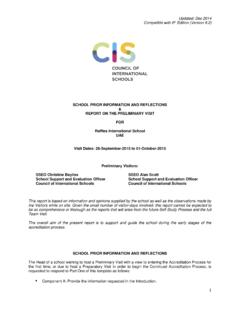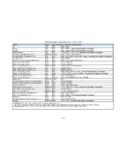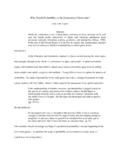Transcription of FW FRAMING PUBLIC ISSUES - FrameWorks Institute
1 FRAMING PUBLIC ISSUESFRAMINGPUBLICISSUEST oolkit Table of ContentsI. FRAMING a Message: How to Think About Frame Analysis and Policy Making:7 Where Does SFA Fit into Strategic Plan?III. Thinking Strategically About FRAMING : Elements of the Frame:Elements of the Frame A. Context16B. Numbers19C. Messengers22D. Visuals24E. Metaphors and Simplifying Models26F. FRAMING Important Definitions35VI. FRAMING TechniquesA. Communications Traps to Avoid: Don t Think About Elephants38B. Bridging42 VII. A FrameWorks Bibliography51 FRAMEWORKS1776 I Street, NWn9th floornWashington, DC C ) FrameWorks Institute 2002 Standard rules of attribution and citation with respect to intellectual property should be followed; no part of this Toolkit may bereprinted without the written consent of the FrameWorks InstituteFRAMINGPUBLICISSUESFRAMING PUBLIC ISSUESABOUT THIS TOOLKITThis Toolkit was created by the FrameWorks Institute to help ISSUES advocates learn andapply new communications thinking to frame their work for better PUBLIC understanding andengagement.
2 We hope that these tools will inspire new thinking and new techniques amongpolicy experts and advocates who seek to resolve social problems whether for childrenand families in a particular state or for the global environment. FRAMING PUBLIC ISSUES , the Workshop and the Toolkit, bring to ISSUES advocates some ofthe most exciting new thinking on communications. The FrameWorks Institute , in partnershipwith a research team of scholars and practitioners, has pioneered a new approach tocommunicating social ISSUES called strategic frame analysis. This approach incorporateskey concepts from the cognitive and social sciences that govern how people processinformation, especially news, with special emphasis on social problems, from adolescentdevelopment and child care to low-wage work and violence prevention. In the pages that follow and in the trainings that often accompany this Toolkit, you will learnhow to answer questions like the following: What shapes PUBLIC opinion about the issuesthat affect children, families, poor people, communities?
3 What role does the news play?How do policymakers gauge PUBLIC opinion? How can I do a better job of helping peoplesee the realities my organization struggles to address every day? The answers to thesequestions will help you translate your vision of what can be done to improve PUBLIC life intoa language that engages ordinary people and advances their interest in policy andprogram work of many collaborators is reflected in these pages. Most prominently: Franklin , Jr., , Associate Vice Chancellor, Community Partnerships and Director, Centerfor Communications and Community, UCLA; Axel Aubrun and Joe Grady from CulturalLogic; and Meg Bostrom with PUBLIC Knowledge. We also wish to thank Lauri Andress forwriting the section on Strategic Frame Analysis and Policy Making. We encourage you tostay in touch with our work through our Website, , where weroutinely post foundation-sponsored multi-method research on PUBLIC perceptions ofnumerous social ISSUES .
4 Please note that, should you wish to quote from or use parts of this Toolkit, standard rules of citation and permission apply. Please consult the FrameWorks Institute for permission todistribute multiple Nall BalesPresident, FrameWorks InstituteApril 2005 FrameWorks Institute 2002 FRAMEWORKSFRAMINGPUBLICISSUESI. FRAMING A Message: How to Think About FrameWorks Institute works with nonprofit groups and philanthropic foundations todocument how the American PUBLIC understands various social ISSUES and how nonprofitcommunicators can frame the PUBLIC discourse on those ISSUES to advance policy do this, we have developed an approach called strategic frame analysis (SFA), a newway of thinking about communications that FrameWorks believes is especially relevant to thetypes of social ISSUES addressed by Workshop participants. What follows is an overview ofthis approach, with examples and applications provided in subsequent pages.
5 For thosewho are interested in learning more about this perspective, we invite you to visit ourWebsite at , and to peruse techniques and examples postedonline from a variety of ISSUES arenas. FrameWorks also offers an online, interactive work-shop at (passcode: j51qiu), focusing specificallyon children s ISSUES . The way in which the world is imagined determines at any particular moment what men will do. Walter Lippmann, PUBLIC Opinion, 1921 When ISSUES advocates approach communications, they do so with three important questionsin mind:1. How do we get people to think about our ISSUES ?2. How do we get them to think about our ISSUES in such a way that they will want to solvethem through PUBLIC policies, not only through individual actions?3. How do we get them to think about ISSUES in such a way that they want to solve themthrough our PUBLIC policies?Strategic frame analysis FrameWorks approach to communications is based on adecade of research in the social and cognitive sciences that demonstrates that the answersto these questions relates to what Walter Lippmann called the pictures in our heads.
6 People use mental shortcuts to make sense of the world. These mental shortcuts rely on frames, or a small set of internalized concepts and values that allow us to accord meaningto unfolding events and new information. These frames can be triggered by various elements,such as language choices and different messengers or images. These communicationselements, therefore, have a profound influence on decision are existing constructs that allow us to interpret developing events. WilliamRaspberry, writing in The Washington Post,explains the power of frames when he says, People use mental shortcuts to make sense of the world. Incoming information provides cues about where to file it mentally. People get most information about PUBLIC affairs from the news media which, overtime, creates a framework of expectation, or a dominant frame. Over time, we develop habits of thought and expectation and configure incoming information to conform to this RESEARCH SUGGESTSFRAMEWORKSFRAMINGPUBLICISSUESI.
7 FRAMING A Message: How to Think About Perhaps the only way we can assimilate new information is by fitting it into the frameworkof something we already understand. He goes on to explore the meaning of terrorism bythinking about America and black people. And, in so doing, he demonstrates the way ourjudgments about political ISSUES can be influenced by the frame we use to make sense ofnew situations. Thinking about the civil-rights movement, Raspberry writes: When we saw itas a choice between civil progress and bloodshed, our minds went one way. When we sawthe choice as between siding with brutal law enforcement and siding with black folkdemanding change, our minds went the other way. Raspberry has elegantly illuminated theframing process that is so critical, if invisible, to political DO PEOPLE GET THEIR FRAMES OF PUBLIC AFFAIRS? Most people don t think about most ISSUES most of the time, write Nelson Polsby andAaron Wildavsky in a famous analysis of American PUBLIC opinion.
8 The PUBLIC has littledaily contact with many ISSUES on the PUBLIC agenda, yet their opinions greatly influencepolicymaker priorities and behavior. Traditionally, news media is the main source ofAmericans information about PUBLIC affairs. In this way, the media dramatically influenceswhat ISSUES the PUBLIC and their policymakers will address. Moreover, messages conveyedby mainstream media take on the value of PUBLIC narratives about the ways of the , media doesn t simply tell us what to think about, it tells us how to think about coverage influences:What ISSUES people think are important for government to address (agenda-setting)The lens through which people interpret ISSUES ( FRAMING ), andWhat information will prove relevant for social and political judgments (priming).Our research on young adults/teens, for example, included an investigation of how the newsmedia covered the issue .
9 This analysis sought to chart the volume of coverage to see if teens figured on the national agenda, to isolate the way the media was FRAMING the issue how itwas telling the teens story. We looked for explanations of cause, not merely effect, and for theinclusion of solutions and policy debates in the coverage. We did so because we know that different kinds of frames have different kinds of effects on PUBLIC opinion. Frames are organizing principles that are socially shared and persistent over time, thatwork symbolically to meaningfully structure the social world. Stephen D. Reese, FRAMING PUBLIC Life, 2001 WHAT IS A FRAME? The use of either the episodic or the thematic news frame affects how individuals assignresponsibility for political ISSUES ; episodic FRAMING tends to elicit individualistic rather thansocietal attributions of responsibility while thematic FRAMING has the opposite effect.
10 Sincetelevision news is heavily episodic, its effect is generally to induce attributions of responsibilityto individual victims or perpetrators rather than to broad social forces. Shanto Iyengar, Is Anyone Responsible?,1991 FRAMEWORKSFRAMINGPUBLICISSUESI. FRAMING A Message: How to Think About episodic frame presents a portrait, while the thematic frame pulls the camera back topresent a landscape. The importance of this distinction is that the two types of frames havevery different effects on how people view a given problem--and whether people will see theneed for individual-level and/or broader environmental or institutional solutions to that frames reduce life to a series of disconnected episodes, random events or casestudies. Betty Jones and her family of four are braving the elements tonight because thehomeless shelter was full, begins an episodic story on the homeless. Such a news storymight go on to describe how the children miss their toys, how cold it is, when they last ate,etc.








